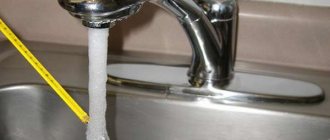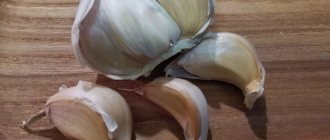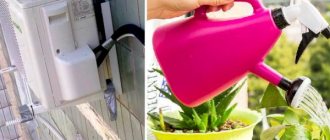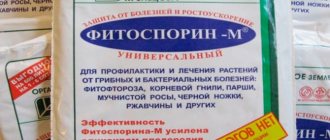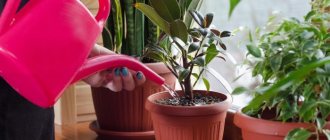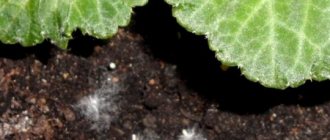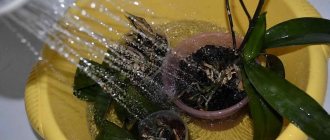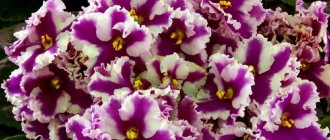Water for watering indoor plants
Houseplants are like children, each with their own character and mood.
One likes to be frequently turned around an axis, the other, on the contrary, try it, move it from place to place, and the bud will fall off without ever blooming. But from excess or lack of moisture, green pets are capricious in different ways: either restrainedly drooping their leaves, or desperately dying. Any gardener knows that it is not worth watering flowers with immediately collected tap water; it contains harmful substances used by our domestic industry for disinfection. Therefore, you should pour water into the container and let it sit for several hours or days. It is not advisable to water with cold water, because... plants experience shock; heat-loving indoor plants may die due to root rot. It is necessary to take at room temperature or 1-2 degrees higher.
It is also not recommended to water with boiled water - it is “dead” and does not have dissolved air or microelements. There will be no harm, but no benefit either. As for rain or melt water, it has always been considered optimal for irrigation. But now it is necessary to make allowances for the state of the environment. If you live far from industrial production or major highways, precipitation water can be beneficial for plants. In megacities with such water, it is better not to take risks. The same applies to river or well water.
In today's environmental conditions, it is preferable to water indoor flowers with artesian drinking water, but not with mineral water.
Experienced gardeners advise using aquarium water for irrigation, and if you take its bottom layer, you can combine watering with fertilizing, since sludge has always been a good fertilizer. But it is worth remembering that you will get beautiful, juicy leaves on the flowers, but they may refuse to bloom - and there should be a measure of fertilizer. After all, if there are a lot of fish and little vegetation in the aquarium, there will be excess nitrogen in the water.
When talking about water, it is necessary to seriously focus on water hardness. Hardness is the capacity of calcium and magnesium salts per unit volume of water, expressed in mEq/l.
Define:
- soft – up to 3 mEq/l
- medium hardness – 3-6 mEq/l
- hard – more than 6 mEq/l
- very hard – over 9 mEq/l
Watering with hard water has harmful effects on plants, namely:
- the accumulation of calcium and magnesium salts changes the acidity of the soil towards an alkaline reaction - camellias, azaleas, ferns that prefer acidified soil die;
- difficulty in normal absorption of essential nutrients by plants;
- reduction of resistance to non-infectious diseases - spotting, dry and wet rot.
The dangers of drinking hard water for people
Excess magnesium and calcium negatively affects the condition:
hair (as a result of washing it) – growth slows down, hair loss increases, dandruff develops, and bald patches appear;
teeth – they crack and become loose, the enamel chips and carious zones form;
bones - they become more brittle and susceptible to arthritis and arthrosis.
Constant deposits provoke the formation of stones that disrupt the normal functioning of the kidneys, liver, and intestines. At the same time, gastric motility also decreases: digestion slows down, more digestible food goes into fat reserves, which contributes to rapid weight gain. Over time, cardiovascular diseases also develop: being in a latent form and not manifesting themselves, they turn into pericardium, epicardium, endocardium or myocardium.
Interacting with soap and shampoos, salts precipitate, clogging pores. Hence the feeling of tight and dry skin after showering or washing. The fat layer gradually disappears, oxygen does not pass through the epidermis, which causes redness and other irritations, rashes, pimples, and acne appear. We have to restore microflora and, in general, health with the help of masks, creams and other means, often expensive, although we need to fight not the consequences, but the cause.
Separately, we note that hard water is also harmful to animals: the excess salts it contains accumulate in the bodies of our pets and lead to digestive problems, decreased immunity, and poor-quality increase in volume.
The same dogs or cats lose their appetite, to the point that they completely refuse their previously loved food, get sick more often (and can catch a cold very easily), they gain weight, but this is not muscle or fat, but accumulations of fluid, already in middle age stones appear, which means problems with the kidneys and liver. Cows' milk yield decreases - from 14-20 to 10-14 liters per day - and their mood also deteriorates, which negatively affects the taste of the milk (it becomes bitter).
Source
How to soften water for irrigation
There are many ways. The simplest ones for home use are the following:
- Add charcoal to the settled water at the rate of 3 g per 1 liter of water (oak and chestnut wood cannot be used to produce charcoal);
- A fabric bag filled with 100 g of fresh peat is placed in a 10-liter container for a day - then you can even wash your hair with this water.
If the home plumbing system is equipped with a filter for purifying drinking water, the problem of hardness is eliminated; filtration usually removes calcium and magnesium salts from the water.
There is also a chemical method of softening water; quite often this method uses oxalic acid, but there is a serious caveat - you need to know exactly the hardness of the water - otherwise the slightest imbalance will cause an undesirable reaction in indoor plants. A digital tester for determining hardness can be purchased at a flower shop or online store.
Using a filter
Jug filtration and a faucet attachment are easy to use, take up little space in the household, purify water from mechanical impurities, and remove chlorine compounds. But this is a long process; you constantly need to add water to the jug filter, but it will gradually leak out. At the same time, it will slowly flow from the faucet nozzle in a thin stream. You should always remember to change the cassette in a timely manner.
A membrane-type flow filter is considered one of the best ways to soften water. It removes:
- sand;
- rust;
- harmful and chemical substances.
Install such a filter on the table or under the sink.
Amount of water for irrigation
When watering indoor flowers, you should never forget about the amount of water. You need to figure out what type of watering your plant requires - abundant, moderate or sparse, and remember - in summer the soil dries out faster, therefore, the plant needs more intensive moisture than in winter.
Abundant - the soil should always remain moist, but the top layer should dry out between waterings. Spathiphyllum and monstera require abundant watering.
Moderate - the top layer of soil should dry out 2-3 cm between waterings. This is how ficus, dracaena, orchids, and aloe are watered.
Rare - the soil should dry out by about 2/3, but not dry out completely. Cacti and other succulents require infrequent watering.
Finally, there are two restrictions for watering:
- the soil should not be too wet even for moisture-loving indoor flowers, except for a few minutes after receiving moisture;
- the soil in the pot should not dry out too much, even for drought-resistant plants, with the exception of cactus.
What to do: treatment measures
If plants are regularly watered with hard water, you must:
- Immediately switch to soft water.
- If necessary, remove the top layer of soil.
- Acidify it.
Soft water sources
The most harmful in terms of hardness is tap water, as well as water from artesian wells. Some summer residents believe that artesian water is beneficial, but groundwater also passes through calcareous rocks, which increases the hardness index. It all depends on the region, of course. If where you live there are deposits of limestone, dolomite or gypsum, the water will pick up a lot of impurities.
We water the flowers correctly!
We water the flowers correctly!
Just as a person is unable to live without water and food, the life of representatives of the plant world is unthinkable without watering. The need for water varies among different plants and is determined by their characteristics: the structure of the stems and leaves, the power of the root system, etc. Water for watering flowers must be neutral in its acid-base state and contain as few harmful impurities as possible (salts of heavy metals, chlorine, fluorine, etc.). The acidity of the water (pH) is of great importance. The pH value is a measure of the amount of free hydrogen ions contained in water. Increased or decreased acidity can not only harm the health of the plant, but also lead to its death. The pH of drinking water ranges from 6 to 9. And the pH of water for irrigation should be in the range of 5.8 - 6.2. It is convenient to control the pH of water using the “electronic pH meter KL-009(I)A” device, which can be purchased in our store. You can use it easily, just do not forget to calibrate it monthly to improve the accuracy of measurements. You can also purchase the calibration solution from us. In addition to an electronic device for measuring pH, you can use a liquid ph test. Measurement range from 4.0 to 8.5. The test is highly reliable and low priced. By adding two drops of the test to a test tube with the test liquid and comparing the resulting color of the solution with the color chart attached to the test, you will instantly get the result and be able to adjust the acid-base state of the water for irrigation.
Read a more detailed article - What is ph
Water softeners
To soften tap water and remove harmful impurities, you can use a number of special products. These include:
- Filter jugs. As a rule, the container holds approximately 3 liters of water; purification occurs through a filter cartridge that retains salts and various impurities.
- Reverse osmosis. Such a filter system costs a lot of money, but is the most acceptable option. The device is connected directly to the pipes, and filtration occurs using special concentrated solutions. Water purified in this way is intended for bathing and household needs, but it is not suitable for drinking, since the active substances involved in the purification process “kill” not only harmful, but also beneficial components.
- Ion exchange water softeners. With the help of these devices, you can not only purify water from impurities, but also enrich its composition with useful minerals. This water is suitable for drinking and bathing.
What is the best water to use for irrigation?
Filtered and settled
Drinking water for the needs of the population is disinfected with chlorine; it contains hardness salts. Watering potted crops with it is dangerous: salts coat the roots with a coating that prevents them from absorbing moisture. The plant is suffering. Therefore, before watering, the liquid is passed through flow filters.
Watering indoor flowers
Precisely calculated doses of chlorine are safe for people. But it is destructive for a home greenhouse - it is a strong oxidizing agent, and the roots get burned.
To neutralize the effect of a toxic substance, place tap water in an open container for a day, then water and spray the plants. An added benefit is that it becomes the same temperature as the potting soil.
Important! Plants do not tolerate cold showers or moisture. The optimal temperature is room temperature.
Watering with settled water
Is it possible to water flowers with mineral water?
Mineral water is a rich natural source of salts and microelements. Contains calcium and magnesium needed by flowers. It would seem like an ideal watering option. But according to agricultural technicians, this cannot be done. Salts in high concentrations make it hard. The soil in flower vases quickly becomes salty. Bicarbonate and alkalis depress plantings. Pets wither, buds fall off
Begonias are tolerant of mineral water, but the gas is released from it before use.
Distilled water
This is a liquid obtained in distillers, without natural salts.
Gardeners are not unanimous in their opinion whether it is possible to water indoor flowers with distilled water.
It is neutral in acidity. It's good for plants. But if you constantly water indoor crops with it, it will wash nutrients from the soil and deplete it. In a poor substrate, flowers do not develop properly. But this is an alternative to hard water.
Important! Distilled water does not harm plants if mineral fertilizers are dissolved in it.
How to soften water at home for watering flowers
Rain, melt, and river life-giving moisture is ideal for ornamental crops. But collecting it, especially in the city, is difficult. Then they look for ways to soften water at home for watering indoor flowers.
Several methods are used:
- stand for 24 hours;
- add 100 grams of peat per 10 liters of water;
- To soften, add 1 tbsp. l. citric acid per 10 liters of water;
- use hot tap water (it is softened in boiler rooms). Cool before watering;
- They make a water purification filter from thick fabric, cotton wool, or activated carbon. They put everything in several layers and wrap it around the faucet. Apply low pressure and pour into the dishes.
If the hardness is more than 10 mg eq per 1 liter, gardeners know what to do and how to soften the water for watering indoor plants. They determine the indicator in laboratories, or purchase a pocket tester - it gives the result in 3 seconds.
Prevention measures
The main preventive measure is watering the soil with melted water, rainwater or pre-treatment of the liquid or soil to acidify it, as described above. It is recommended to pay attention to other practical tips:
- Buy an inexpensive pH meter so that you can accurately and quickly measure the pH of water and water infusion of the soil (fill with a small amount of water, let stand overnight and take the measurement).
- Be sure to mulch the plantings with peat, sawdust, pine needles and other organic matter. It slightly acidifies the soil, i.e. reduces hardness after watering. In addition, thanks to mulch, the soil retains moisture longer, so water can be given less often.
- The drainage layer (pebbles, expanded clay, other small stones) allows excess water to be drained to great depths. If groundwater approaches the surface close to the surface, drainage protects the plant roots from being washed away and rotting.
Thus, hard water is not suitable for watering almost all crops. Moreover, the greater the rigidity, the worse the effect of such a liquid on plant tissue. If it is known that in the region this indicator is too high (the entire middle zone, the Volga region, the Black Earth Region, the Southern Urals and South-Western Siberia), it is necessary to take special measures - otherwise the harvest may significantly decrease.
Source
Is it possible to water flowers with beer?
Flower fans on forums discuss not only what kind of water is suitable for watering indoor plants, but also what else to irrigate their pets with.
Gardeners know about the benefits of yeast - they are used as a top dressing.
Yeasts are fungi. In the ground they awaken microorganisms that actively process organic matter. A lot of nitrogen and potassium are released, which are necessary for green spaces.
The soil in a flower pot is quickly depleted, and yeast comes in handy here. They are found in abundance in beer. Without even doubting whether it is possible to water flowers with beer, flower growers practice this method.
The beer method is beneficial only if the drink is “alive”. Preservatives and stabilizers, which preserve bottled beer for up to six months, are harmful to plantings.
The indoor rose is considered a beer “admirer”. Money trees, dracaenas, and spurges are tolerant of such moisture.
Important! Before watering, “live” beer is diluted with water in the ratio: 1 part intoxicating drink to 10 parts liquid.
The table shows signs of lack or excess watering of houseplants.
Wet, may have a sour or musty smell, the smell of mold, there is water in the pan.
Slowdown. Increased growth of green mass during the flowering period.
Tender leaves droop and become limp. Dense, leathery leaves dry out. The old leaves fall off first.
They droop, turn yellow, the tips turn brown, there are softened areas with signs of rot. Both young and old leaves fall off.
| Signs of lack of water | Signs of excess water | |
| The soil | Dry, cracked, hard, falling away from the walls of the pot. | Slowing down or stopping |
| Condition of the leaves | ||
| Condition of the roots | Drying, thinning. | Rotting, limpness, smell of rot. |
| Condition of buds and flowers | They wither and/or fall off quickly. | Presence of mold. |
Growing plants hydroponically will help you avoid underwatering or overwatering. Read about this in the article: What is hydroponics?
Is it possible to water indoor flowers with water from an aquarium?
An aquarium is a closed ecosystem. Microorganisms and bacteria live in it. Dissolved minerals, vitamins, humic acids. The liquid is warm and oxygenated. Inhabitants are fish and snails, which add urea.
Water from an aquarium is no longer just life-giving moisture, but an organic substrate.
Regarding its use, the opinions of flower growers are completely opposite. Some consider aquarium substrate an elixir for moisture-loving species. They notice the lush flowering and lush greenery of the potted inhabitants. Others are not seeing fantastic growth.
Even specialists are not enthusiastic about the method. The undoubted benefits are considered:
- temperature of the irrigation liquid;
- savings on fertilizing;
- oxygen saturation;
- no chlorine.
But it cannot be called clean, even despite the filters. There will be no harm to plants from aquarium liquid if you moisten the soil periodically - once a month.
Important! Before watering, the aquarium substance is aerated by blowing atmospheric air through the water column with an aerator.
Aquarium - organic substrate
Softening drinking water: basic methods and ways to make water softer
Increased rigidity can and should be fought. Therefore, we will consider in detail the existing softening methods, starting with why to soften water, continuing with which method to give preference in a given situation, and ending with what kind of equipment to choose to implement the plan.
Let us immediately note that even the intake from an artesian well is not 100% pure; it still contains impurities (albeit in a lower concentration) that should be gotten rid of. The presence of these undesirable additives can be detected both in laboratory conditions - the most accurate option - and by taste or even visually: by low foaming, the appearance of plaque on the surfaces of plumbing fixtures, and increased consumption of household chemicals.
Is it possible to water indoor flowers with serum?
People are returning to nature, everything natural: fabrics, food, drinks. This slogan was transferred to home flora. Now the question is no longer which liquid to choose for irrigation. They take natural products, without pesticides and chemicals. Whey came under the gun. And for good reason.
The whey is acidic. Useful substances: amino acids, trace elements, phosphorus, potassium, lactic bacteria. An invaluable fertilizer and pest suppressant. An undiluted product will damage the flora and disrupt the soil balance. Suitable ten times mixed with liquid. This is the base solution.
- Add 0.5 kg of sugar per 10 liters and a pinch of yeast to the whey solution. Fill the cut grass.
- Dissolve iodine in diluted whey (10 drops per 10 l), add ash.
To water under the roots, dilute 1 part fertilizer in 10 parts of liquid. For spraying, take 1 liter of solution for 3 liters of water.
Important! In a dormant state, plants are not fed with whey.
Serum for watering a home greenhouse
Stand up for
This is one of the most popular methods that gardeners have been using for many decades.
Ordinary tap water is poured into a container convenient for watering and left to stand at room temperature for 24 hours. Thus, hardness salts and other suspended matter precipitate to the bottom, and an almost pure liquid remains on top. The hardness during this treatment most likely will not drop to the normal value, but the water will still soften and become suitable for plants.
IMPORTANT: It is better to use water prepared by settling within 2-3 days, otherwise stagnation processes will begin, which can have a detrimental effect on your plants.
Is it possible to water flowers with tea leaves and tea?
Chemical analysis of tea shows: tannins, potassium, manganese, iron.
The debate among forum members about the benefits of tea leaves as a means of fertilizer does not subside.
- the acidity of the substrate increases;
- air penetrates better into the soil;
- compost is activated;
- clay soils are loosened;
- Mulching retains moisture.
- flower growers have a sufficient selection of universal fertilizers to use dubious ones;
- scented additives upset the soil balance;
- the sweet drink breeds pests: fungus gnats, midges;
- moldy tea leaves introduce bacteria and fungi into the ground;
- the soil turns sour.
An easy way to check if your water is suitable for watering your plants
Hello everyone who follows the florist's notes section.
Today I will share with you the results of my experiment to determine the appropriate water for watering my favorite plants.
I was inspired to get confused about this topic by streptocarpus, which, more than other plants, despise dissolved mineral salts in water, do not like high Ph and suffer intensely from these factors.
Streptocarpus variety Spin Art
So some gardeners complained to me that they could not make friends with these plants.
It seems that the soil is suitable and the lighting is good, but for some reason the streptocarpus are dying.
For some reason, we don’t pay any attention to irrigation water, but this is very important. I think this is what causes problems for some Streptocarpus breeders.
Not only streptocarpus react painfully to inappropriate water, but other flowers too.
Violets will never show you what they are capable of and what caps they can bloom in if you water them with hard tap water.
Begonias can rot from improper water.
Signs of excessive water hardness:
- white stains begin to appear on clay containers, which indicate a high concentration of lime in the liquid for watering flowers;
- A white crust forms on the surface of the earth.
Since water is vital for plants, it is necessary to take care of its quality characteristics. And then your flowers will delight you with good health and beautiful appearance.
What kind of water do you use for irrigation?
